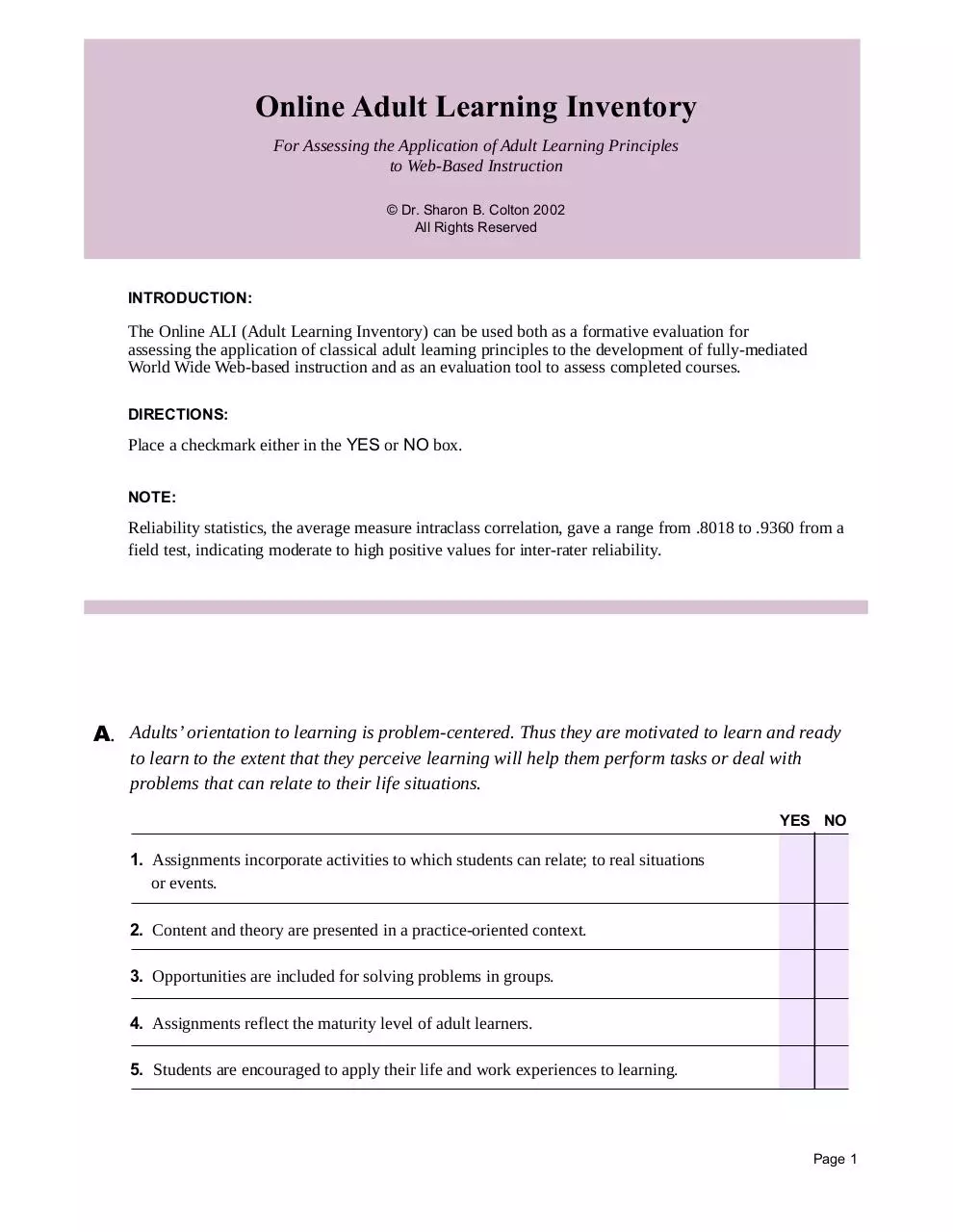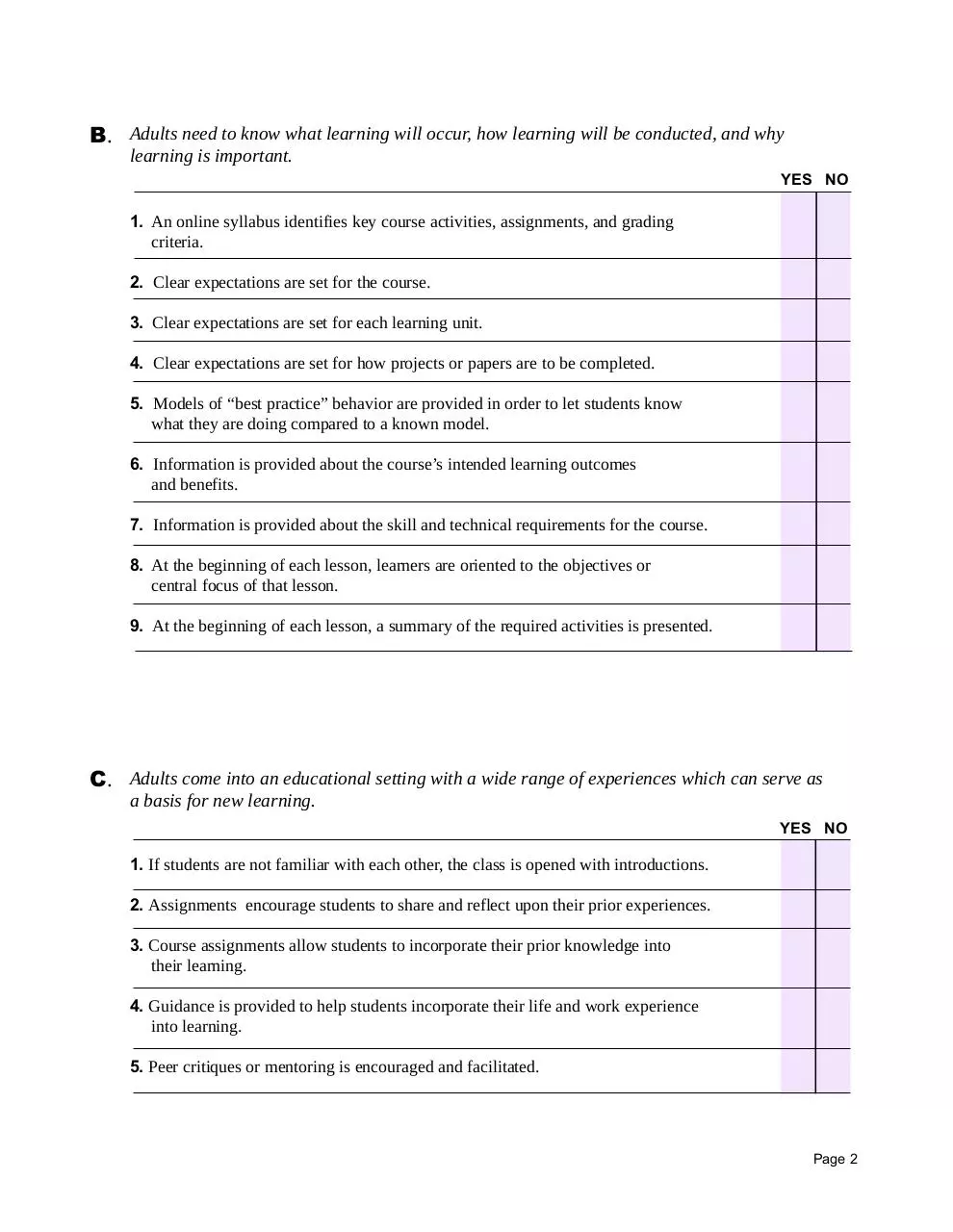Online Adult Learning Instrument (PDF)
File information
Title: Online ALI
Author: Dr. Sharon B. Colton
This PDF 1.2 document has been generated by Adobe PageMaker 6.52 / Acrobat Distiller 4.0 for Macintosh, and has been sent on pdf-archive.com on 24/04/2013 at 23:03, from IP address 216.255.x.x.
The current document download page has been viewed 885 times.
File size: 25.03 KB (4 pages).
Privacy: public file




File preview
Online Adult Learning Inventory
For Assessing the Application of Adult Learning Principles
to Web-Based Instruction
© Dr. Sharon B. Colton 2002
All Rights Reserved
INTRODUCTION:
The Online ALI (Adult Learning Inventory) can be used both as a formative evaluation for
assessing the application of classical adult learning principles to the development of fully-mediated
World Wide Web-based instruction and as an evaluation tool to assess completed courses.
DIRECTIONS:
Place a checkmark either in the YES or NO box.
NOTE:
Reliability statistics, the average measure intraclass correlation, gave a range from .8018 to .9360 from a
field test, indicating moderate to high positive values for inter-rater reliability.
A. Adults’ orientation to learning is problem-centered. Thus they are motivated to learn and ready
to learn to the extent that they perceive learning will help them perform tasks or deal with
problems that can relate to their life situations.
YES NO
1. Assignments incorporate activities to which students can relate; to real situations
or events.
2. Content and theory are presented in a practice-oriented context.
3. Opportunities are included for solving problems in groups.
4. Assignments reflect the maturity level of adult learners.
5. Students are encouraged to apply their life and work experiences to learning.
Page 1
B. Adults need to know what learning will occur, how learning will be conducted, and why
learning is important.
YES NO
1. An online syllabus identifies key course activities, assignments, and grading
criteria.
2. Clear expectations are set for the course.
3. Clear expectations are set for each learning unit.
4. Clear expectations are set for how projects or papers are to be completed.
5. Models of “best practice” behavior are provided in order to let students know
what they are doing compared to a known model.
6. Information is provided about the course’s intended learning outcomes
and benefits.
7. Information is provided about the skill and technical requirements for the course.
8. At the beginning of each lesson, learners are oriented to the objectives or
central focus of that lesson.
9. At the beginning of each lesson, a summary of the required activities is presented.
C. Adults come into an educational setting with a wide range of experiences which can serve as
a basis for new learning.
YES NO
1. If students are not familiar with each other, the class is opened with introductions.
2. Assignments encourage students to share and reflect upon their prior experiences.
3. Course assignments allow students to incorporate their prior knowledge into
their learning.
4. Guidance is provided to help students incorporate their life and work experience
into learning.
5. Peer critiques or mentoring is encouraged and facilitated.
Page 2
D.
Because of their prior experience, adults tend to develop mental habits and biases and may
need to reassess their beliefs in order to adopt alternate ways of thinking.
YES NO
1. Orientation activities are provided at the beginning of the course that allow
learners to develop the skills necessary to complete the course (e.g., “introduce
yourself to the discussion forum,” “send me e-mail saying you were able to log on”).
2. The instructor of the course encourages all students to post responses to questions,
read other comments, and reflect. (Threaded discussions allow students to see and reflect
on each other’s responses in comparison to their own, which has an enormous benefit in
assessing different attitudes.)
3. The course provides a conceptual framework that helps learners to develop new
conceptual frameworks or mental models.
4. The instructor uses common language characteristics between old and new models
or concepts and introduces new jargon appropriately.
5. Students are encouraged to share with other students their derivation of meaning
and their progress through discussion postings, reflection papers that are posted, or e-mail.
E. Adults have a self-concept of being responsible for their own decisions, for their own lives,
and their own learning. They need to be provided the tools and opportunities for
independent, self-directed learning.
YES NO
1. The course is designed to allow students to direct their own learning.
2. The instructor provides organizers that allow students to manage study and
homework with minimal questions.
3. The instructor provides flexibility in assignments that allow for students to
work ahead.
4. The instructor encourages and reinforces self-sufficiency through timely
feedback.
Page 3
F.
In any group of adults there will be a wider range of individual differences, thus the
individualization of learning experiences is important in many situations.
YES NO
1. A variety of instructional methods and media are used to meet the differing
needs and learning styles of students.
2. Students can move through the instruction at their own pace.
3. Students can review previous learning whenever they want.
4. The instructor is available to coach students or to suggest outside mentors.
5. The instructor provides links to a wide variety of web resources.
6. Students with different levels of computer skills and resources can succeed in
this course; the course conforms to accessibility requirements.
7. Ample time is allotted for students to master the content.
G. Situational differences, or the context of the learning environment, impact the learning
process of adults.
YES NO
1. Support services are available in this course to meet student needs. (They
may include the following services: textbook purchasing, library services, disability
services, admissions, enrollment, and transfer of credit.)
2. The psychological climate of the course is conducive to learning. It suggests
to the student that the learning activity is going to be rewarding and positive.
3. The screen is easy to read.
4. Directions are easy to follow.
5. The learning resources in this course can be personalized.
6. Students work in small groups.
7. The instructor has a procedure for determining each student’s support structure
in order to find ways to supplement that support structure, if needed.
8. Back up assistance is available to students outside the major communications
media used for this course (800 number, help desk, et cetera).
Page 4
Download Online Adult Learning Instrument
Online Adult Learning Instrument.pdf (PDF, 25.03 KB)
Download PDF
Share this file on social networks
Link to this page
Permanent link
Use the permanent link to the download page to share your document on Facebook, Twitter, LinkedIn, or directly with a contact by e-Mail, Messenger, Whatsapp, Line..
Short link
Use the short link to share your document on Twitter or by text message (SMS)
HTML Code
Copy the following HTML code to share your document on a Website or Blog
QR Code to this page

This file has been shared publicly by a user of PDF Archive.
Document ID: 0000101631.